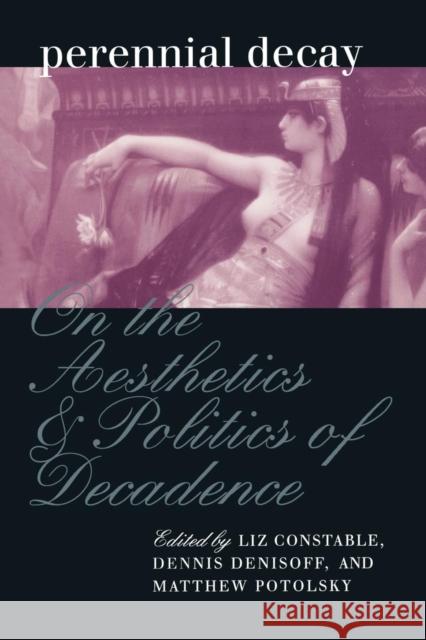Perennial Decay: On the Aesthetics and Politics of Decadance » książka
Perennial Decay: On the Aesthetics and Politics of Decadance
ISBN-13: 9780812216783 / Angielski / Miękka / 1998 / 328 str.
"This splendid collection of essays, with its lucid, witty, and masterful introduction by the editors, will transform our understanding of the decadent aesthetic, and demonstrate its relevance to a wide range of important literature and art in Europe, England, the United States, and Latin America in the past 150 years. It is required and rewarding reading."--Elaine Showalter, Princeton University When Oscar Wilde was convicted of gross indecency in 1895, a reporter for the National Observer wrote that there was "not a man or a woman in the English-speaking world possessed of the treasure of a wholesome mind who is not under a deep debt of gratitude to the marquis of Queensberry for destroying the high Priest of the Decadents." But reports of the death of decadence were greatly exaggerated, and today, more than one hundred years after the famous trial and at the beginning of a new millennium, the phenomenon of decadence continues to be a significant cultural force. Indeed, "decadence" in the nineteenth century, and in our own period, has been a concept whose analysis yields a broad set of associations. In Perennial Decay, Emily Apter, Charles Bernheimer, Sylvia Molloy, Michael Riffaterre, Barbara Spackman, Marc Weiner, and others extend the critical field of decadence beyond the traditional themes of morbidity, the cult of artificiality, exoticism, and sexual nonconformism. They approach the question of decadence afresh, reevaluating the continuing importance of late nineteenth-century decadence for contemporary literary and cultural studies.
"This splendid collection of essays, with its lucid, witty, and masterful introduction by the editors, will transform our understanding of the decadent aesthetic, and demonstrate its relevance to a wide range of important literature and art in Europe, England, the United States, and Latin America in the past 150 years. It is required and rewarding reading."--Elaine Showalter, Princeton UniversityWhen Oscar Wilde was convicted of gross indecency in 1895, a reporter for the National Observer wrote that there was "not a man or a woman in the English-speaking world possessed of the treasure of a wholesome mind who is not under a deep debt of gratitude to the marquis of Queensberry for destroying the high Priest of the Decadents." But reports of the death of decadence were greatly exaggerated, and today, more than one hundred years after the famous trial and at the beginning of a new millennium, the phenomenon of decadence continues to be a significant cultural force.Indeed, "decadence" in the nineteenth century, and in our own period, has been a concept whose analysis yields a broad set of associations. In Perennial Decay, Emily Apter, Charles Bernheimer, Sylvia Molloy, Michael Riffaterre, Barbara Spackman, Marc Weiner, and others extend the critical field of decadence beyond the traditional themes of morbidity, the cult of artificiality, exoticism, and sexual nonconformism. They approach the question of decadence afresh, reevaluating the continuing importance of late nineteenth-century decadence for contemporary literary and cultural studies.











